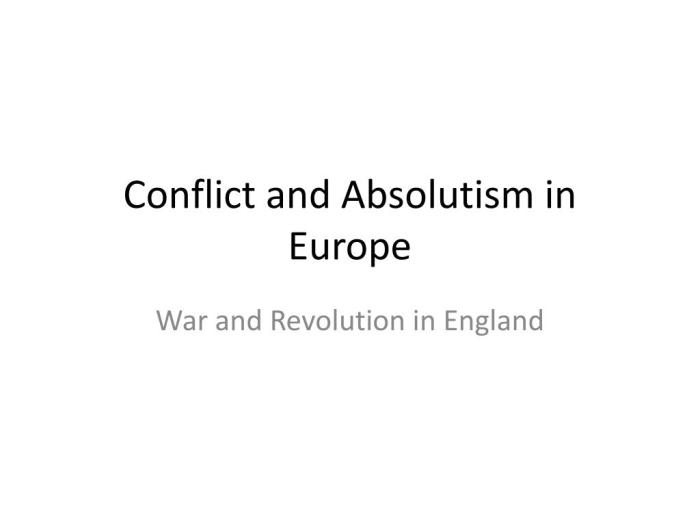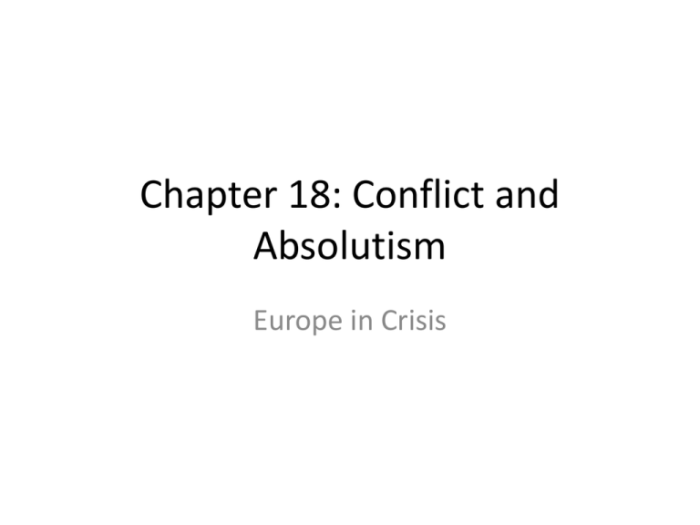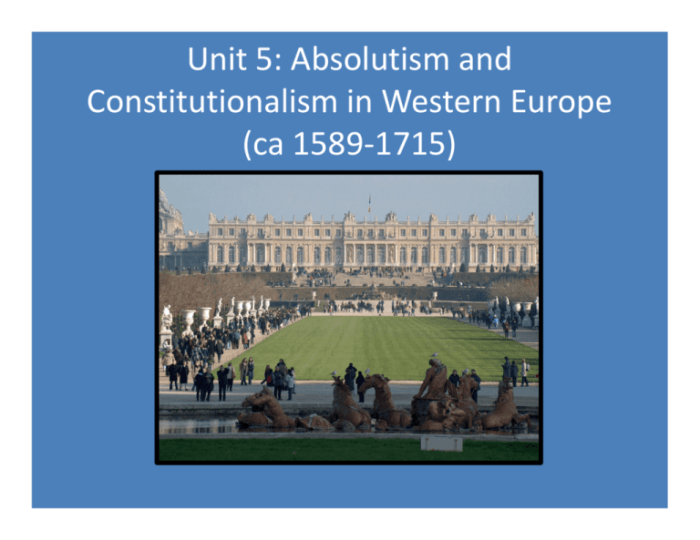Conflict and absolutism in europe – Conflict and absolutism intertwined in Europe, shaping its political, social, and religious fabric. Absolute monarchs sought to consolidate power, leading to tensions within and between nations. This interplay profoundly influenced the balance of power and the development of representative government.
The rise of absolutism, exemplified by monarchs like Louis XIV of France, was fueled by political, economic, and social factors. Monarchs employed various methods to strengthen their authority, including the centralization of power and the suppression of dissent.
The Rise of Absolutism in Europe
Absolutism emerged in Europe during the 16th and 17th centuries, driven by political, economic, and social factors. The Protestant Reformation weakened the authority of the Catholic Church, creating a vacuum that monarchs filled. Economic growth and the rise of the middle class provided monarchs with new sources of revenue, while social unrest led people to seek strong leadership.
Specific Examples of Absolutist Monarchs
Louis XIV of France exemplified absolutism, declaring himself the “Sun King” and centralizing power in his hands. Other examples include Philip II of Spain, Frederick the Great of Prussia, and Elizabeth I of England.
Methods Used to Consolidate Power
Absolute monarchs used various methods to consolidate their power. They established standing armies, appointed loyal officials, and controlled the courts and parliaments. They also promoted mercantilism to strengthen their economies and supported the arts and sciences to enhance their prestige.
Conflict and Absolutism in Europe

Absolutism contributed to conflicts within and between European nations. Monarchs sought to expand their territories and assert their authority, leading to wars and uprisings. Religious differences, particularly between Catholics and Protestants, also fueled conflicts.
Specific Examples of Conflicts
The Thirty Years’ War (1618-1648) was a major conflict influenced by absolutist policies and religious divisions. The War of the Spanish Succession (1701-1714) resulted from the expansionist ambitions of Louis XIV.
Role of Religious Differences and Territorial Disputes
Religious differences and territorial disputes were major catalysts for conflicts during this period. Monarchs used religion to justify their rule and justify wars against rival nations. Territorial disputes also led to conflicts as monarchs sought to expand their empires.
The Impact of Conflict on Absolutism: Conflict And Absolutism In Europe
Conflicts affected the power and legitimacy of absolute monarchs. Wars and uprisings challenged their authority and led to the development of constitutionalism and representative government.
Weakening of Monarchies
Wars and uprisings weakened the power of absolute monarchs. The Thirty Years’ War devastated Germany and led to the rise of constitutionalism in England.
Rise of Constitutionalism and Representative Government
Conflicts led to the rise of constitutionalism and representative government as people demanded a voice in their own governance. The English Parliament gained power, while the French Revolution established a republic.
Absolutism and the Balance of Power in Europe

Absolutism played a role in shaping the balance of power in Europe. European nations formed alliances and engaged in diplomacy to maintain a balance of power amidst the rise of absolutism.
Strategies for Maintaining Balance of Power
European nations used various strategies to maintain a balance of power. They formed alliances, engaged in diplomacy, and subsidized weaker states to prevent any one power from becoming too dominant.
Role of Alliances and Diplomacy, Conflict and absolutism in europe
Alliances and diplomacy were essential for maintaining the balance of power. Nations formed alliances to counter the threat of more powerful states and used diplomacy to resolve conflicts and negotiate treaties.
The Decline of Absolutism in Europe

Absolutism declined in Europe due to Enlightenment ideas, the rise of new social and political movements, and specific events and revolutions.
Enlightenment Ideas
Enlightenment ideas challenged the divine right of kings and promoted the principles of liberty and equality. Philosophers such as John Locke and Montesquieu argued for constitutional government and limited monarchy.
Rise of New Social and Political Movements
The rise of the middle class and the development of new social and political movements, such as liberalism and nationalism, undermined the authority of absolute monarchs.
Specific Events and Revolutions
Specific events and revolutions marked the end of absolutism in different European countries. The English Revolution (1642-1649) established a constitutional monarchy, while the French Revolution (1789-1799) overthrew the monarchy and established a republic.
FAQ Summary
What factors contributed to the rise of absolutism in Europe?
Political, economic, and social factors, including the need for stability, the growth of trade, and the decline of feudalism.
How did absolutism contribute to conflicts in Europe?
By centralizing power and suppressing dissent, absolutist policies exacerbated religious and territorial tensions, leading to wars and uprisings.
What role did religious differences play in fueling conflicts during this period?
Religious differences, particularly between Catholics and Protestants, were a major source of tension and conflict, as monarchs sought to impose their own religious beliefs on their subjects.